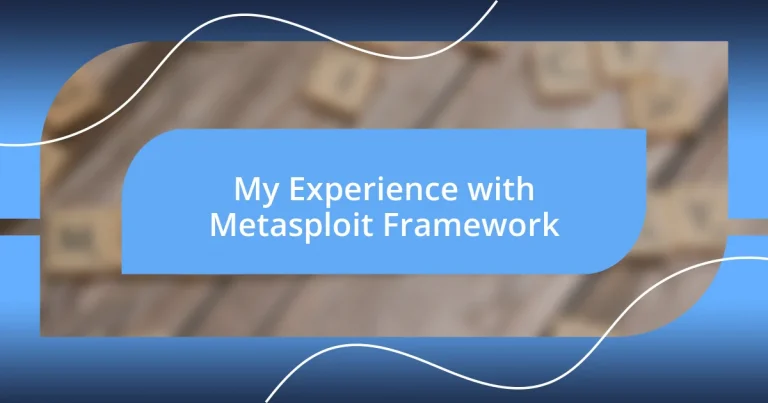Key takeaways:
- The Metasploit Framework is crucial for penetration testing, allowing users to discover vulnerabilities while emphasizing the importance of ethical considerations.
- Setting up Metasploit involves choosing the right operating system (preferably Kali Linux), configuring PostgreSQL, and regularly updating to access the latest tools and techniques.
- Real-world applications of Metasploit demonstrate its effectiveness in enhancing security practices and fostering team collaboration through red and blue teaming exercises.
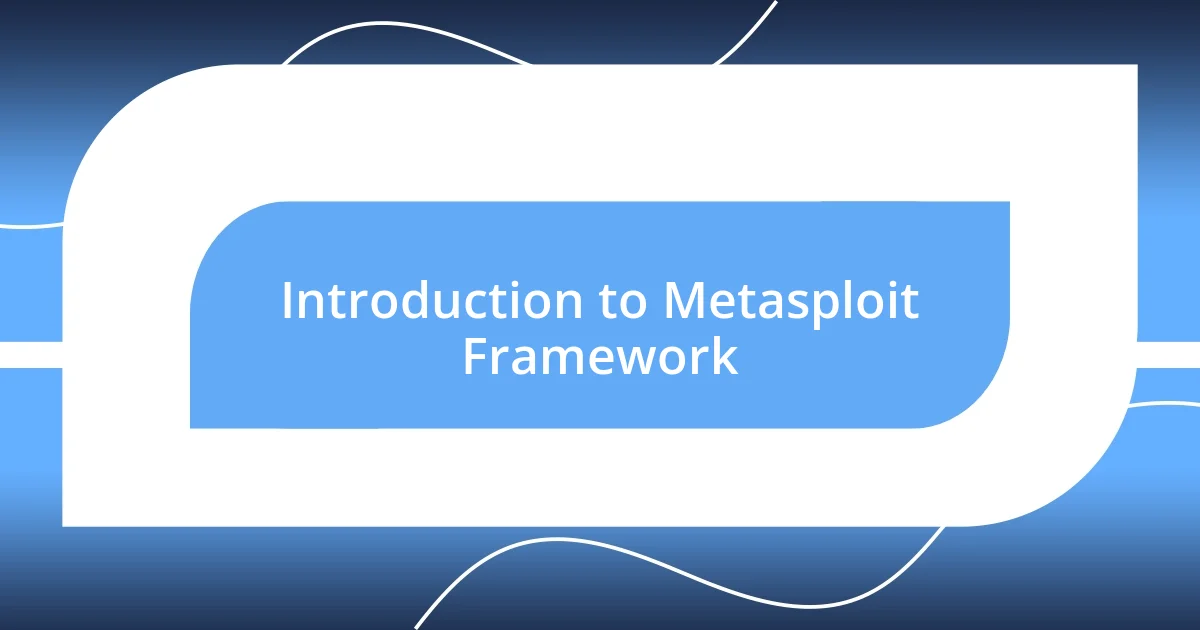
Introduction to Metasploit Framework
The Metasploit Framework is a powerful tool for penetration testing, offering security professionals a way to discover vulnerabilities in systems effectively. When I first encountered Metasploit, I was both intrigued and intimidated—its extensive capabilities felt like a double-edged sword that could either expose weaknesses or accidentally wreak havoc if mishandled.
What truly captivated me was the vast community surrounding Metasploit. It’s a treasure trove of knowledge and collaboration where users share exploits, payloads, and tips. I remember my first attempt to write a custom module; it was challenging but immensely rewarding. Have you ever felt that rush of excitement when you realize you created something truly functional?
Metasploit not only enhances my skills but also deepens my understanding of cybersecurity overall. I often find myself reflecting on its ethical implications—how can we use such knowledge responsibly? It’s a journey that continually pushes me to stay informed, ensuring that I contribute positively to the security landscape.
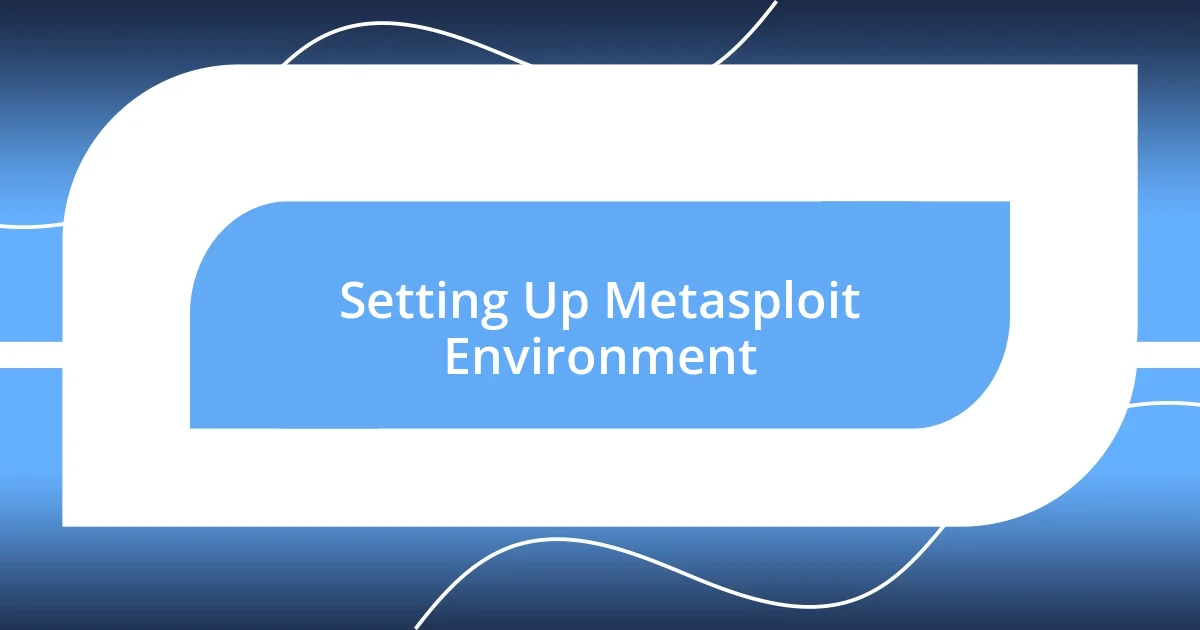
Setting Up Metasploit Environment
When I first set up my Metasploit environment, I followed a process that felt like piecing together a puzzle. I quickly realized that the choice of operating system could significantly impact my experience. Many users opt for Kali Linux due to its pre-installed security tools, which lowers the barrier to entry. I remember the sense of accomplishment I felt when I successfully installed Metasploit for the first time—seeing the command line spring to life was exhilarating!
Next, I encountered the challenge of configuring the PostgreSQL database. I can’t stress enough how essential this step is; it not only organizes my data but also maximizes the framework’s performance. I still recall the nerves I felt as I navigated this setup, but overcoming that hurdle proved crucial for my success. Once configured, the data management capabilities of Metasploit made my testing more efficient and streamlined.
Lastly, I found that keeping my Metasploit updated is vital for accessing the latest exploits and modules. This commitment to staying current gave me a sense of responsibility and continuous learning within the cybersecurity realm. It’s like honing a craft; each update brings new tools and techniques to explore, ensuring that I’m always on my toes. Have you experienced that satisfaction of mastering a new update? It’s what keeps me actively engaged in my pentesting journey.
| Aspect | Details |
|---|---|
| Operating System | Kali Linux is preferred for its built-in tools. |
| Database Configuration | PostgreSQL must be set up for data management. |
| Updates | Regular updates are essential for accessing new exploits. |
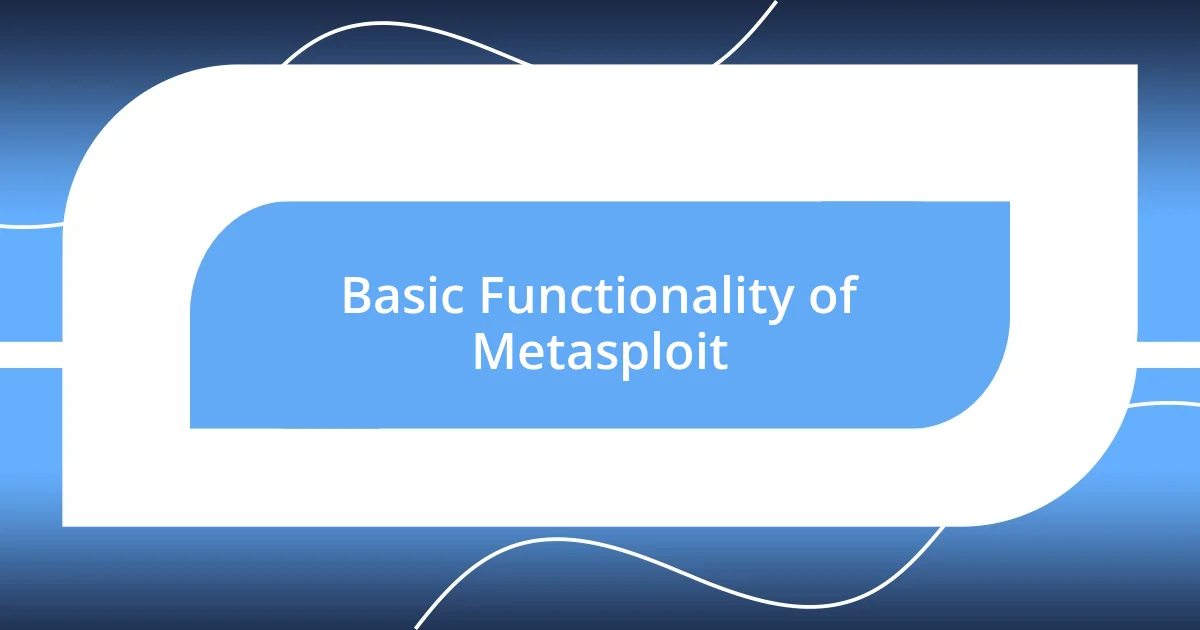
Basic Functionality of Metasploit
The Metasploit Framework shines in its ability to provide a comprehensive suite of tools that simplify the process of finding and exploiting vulnerabilities. When I first began utilizing Metasploit, I was amazed by its organized structure and user-friendly interface. It made the learning curve less daunting and was a game changer in how I approached security assessments. Each module, from exploits to payloads, felt like a unique tool in my cybersecurity toolkit, waiting for the right scenario to come alive.
A key functionality that stood out to me was the ability to create and customize exploits. This flexibility allowed me to experiment and adapt existing modules to suit specific situations, which was both exciting and empowering. I remember the thrill of successfully writing a custom exploit that worked precisely as I intended; it felt like wielding a superpower in the cyber world. The basic functionalities of Metasploit include:
- Exploitation: Launching attacks against known vulnerabilities in systems.
- Payloads: Enabling an attacker to control the compromised system and facilitate further actions.
- Listeners: Establishing a point of communication for incoming connections from payloads.
- Auxiliary Modules: Performing a variety of tasks such as scanning and fuzzing without exploiting vulnerabilities.
Engaging with Metasploit is like having an all-access pass to understanding and simulating real-world attacks. It not only sharpened my technical skills but also deepened my appreciation for the ethical dimensions of penetration testing.
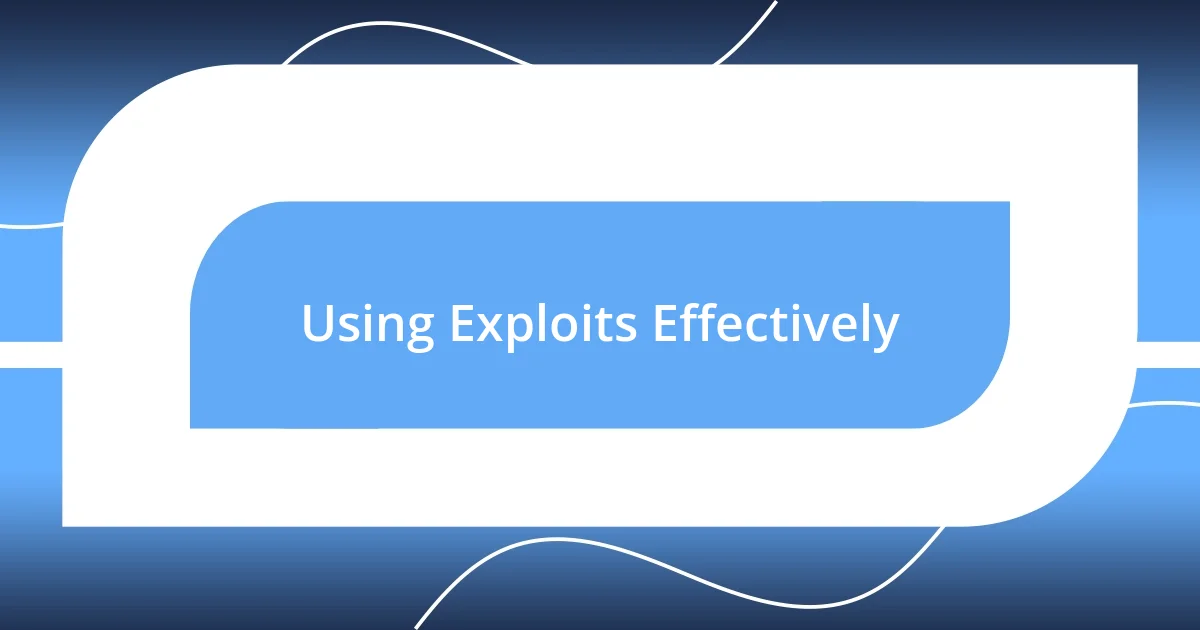
Using Exploits Effectively
Utilizing exploits effectively in Metasploit isn’t just about firing off attacks; it’s about understanding the underlying vulnerabilities and crafting a strategy. In my early days, I found myself getting overly excited about executing exploits without fully grasping the context. I quickly learned that a successful exploit requires not only technical knowledge but also a keen awareness of the target environment. Have you ever jumped the gun on an attack, only to find out it was poorly planned? I certainly have, and it’s a steep learning curve.
I recall a particular incident where I tailored an exploit that targeted a specific version of software I had researched. The moment I executed it and gained access, I felt an incredible mix of satisfaction and responsibility. It’s crucial to remember that every time I exploit a vulnerability, I need to consider the ethical implications. I often ask myself, how can I use this power to improve security rather than just demonstrate capability? This reflective practice keeps my approach grounded and focused on educational purposes.
Moreover, understanding the various payloads is central to using exploits effectively. Once, I faced a scenario where selecting the right payload made all the difference between success and failure. I chose a reverse shell, which allowed me immediate access. That experience taught me the importance of payload selection and how it directly impacts the outcome of an exploit. Have you thought about how critical the choice of payload can be in your exploits? It’s fascinating how a simple choice can lead to entirely different results in penetration testing.
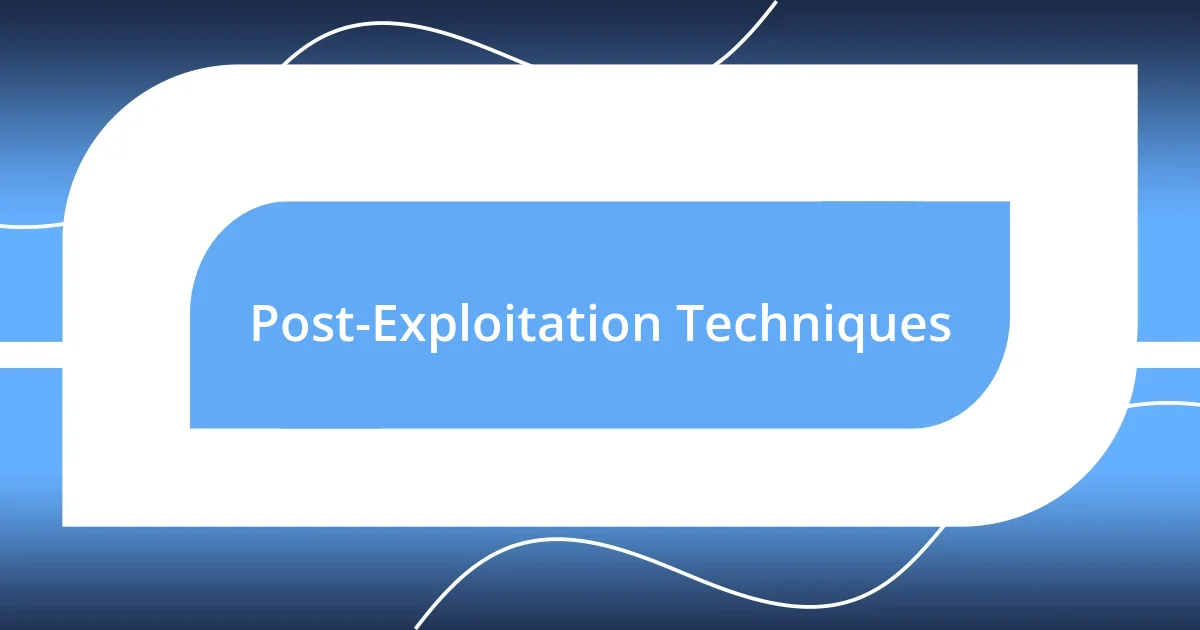
Post-Exploitation Techniques
Post-exploitation techniques are at the heart of truly understanding the landscape once you’ve gained access to a system. I remember the first time I successfully escalated my privileges. It was a pivotal moment. Instead of just being a guest on the network, I could now dive deeper into the system, uncovering sensitive data and configurations that were previously off-limits. I often reflect on how empowering it felt—not just from a technical standpoint, but also from the responsibility that comes with having such access.
One particularly memorable experience involved using the Metasploit post-exploitation module to enumerate users and their privileges. It was thrilling to see firsthand how different permissions could expose or limit what I could access. I couldn’t help but wonder: what might a user with administrative access do with the same capabilities? It highlighted the importance of understanding not just the tools at your disposal, but also the potential consequences of those techniques in a real-world context.
As I continued my journey with Metasploit, I found that employing credential harvesting techniques became essential. There was one instance where I deployed a keylogger and was amazed by how quickly it captured sensitive login information. The realization that I was gaining insights into user behavior—and potentially thwarting attacks against them—made me appreciate the dual-edged sword of these capabilities. Have you ever experienced that mix of curiosity and concern when utilizing powerful tools? It’s this balancing act that shapes how I approach post-exploitation, reminding me that while I wield significant influence, ethical considerations remain paramount.
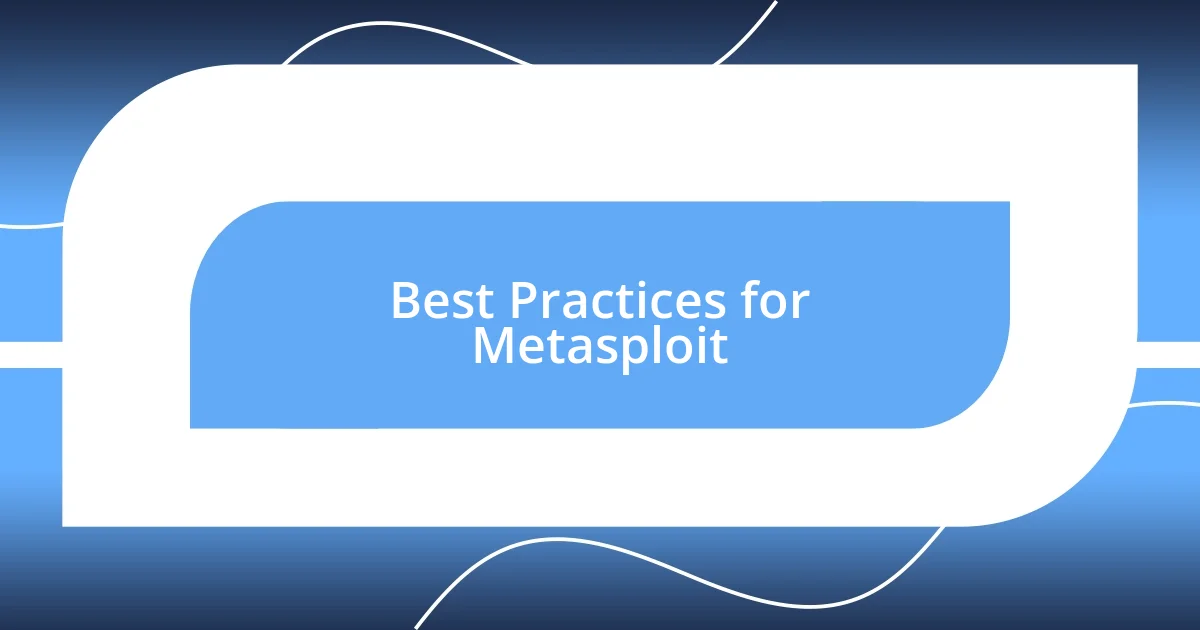
Best Practices for Metasploit
Using Metasploit effectively requires a solid game plan before diving into the action. I recall a time when I rushed into an assessment, eager to showcase my skills, only to discover I had overlooked crucial reconnaissance steps. It’s almost like going on a treasure hunt without a map. Have you ever found yourself taking shortcuts? Trust me, those initial steps can make or break your entire operation.
When it comes to maintaining control during penetration testing, organization is key. I started using custom workspaces within Metasploit to group related sessions and findings. A simple habit, but it transformed my workflow. Have you considered how a little bit of organization might enhance your efficiency? Suddenly, what seemed like chaos became a streamlined process, allowing me to focus on threats rather than losing time trying to remember where I left off.
Lastly, documenting your actions is essential, not just as a reference for future tests, but also for compliance and learning. After completing one assessment, I took the time to write down not just what I did, but why I took certain actions and their impact on the overall system. It felt rewarding to reflect on my thought process, almost like writing a diary of my cybersecurity journey. Have you ever kept track of your learning experiences? That practice not only improved my skills but also clarified my ethical stance on vulnerability exploitation.
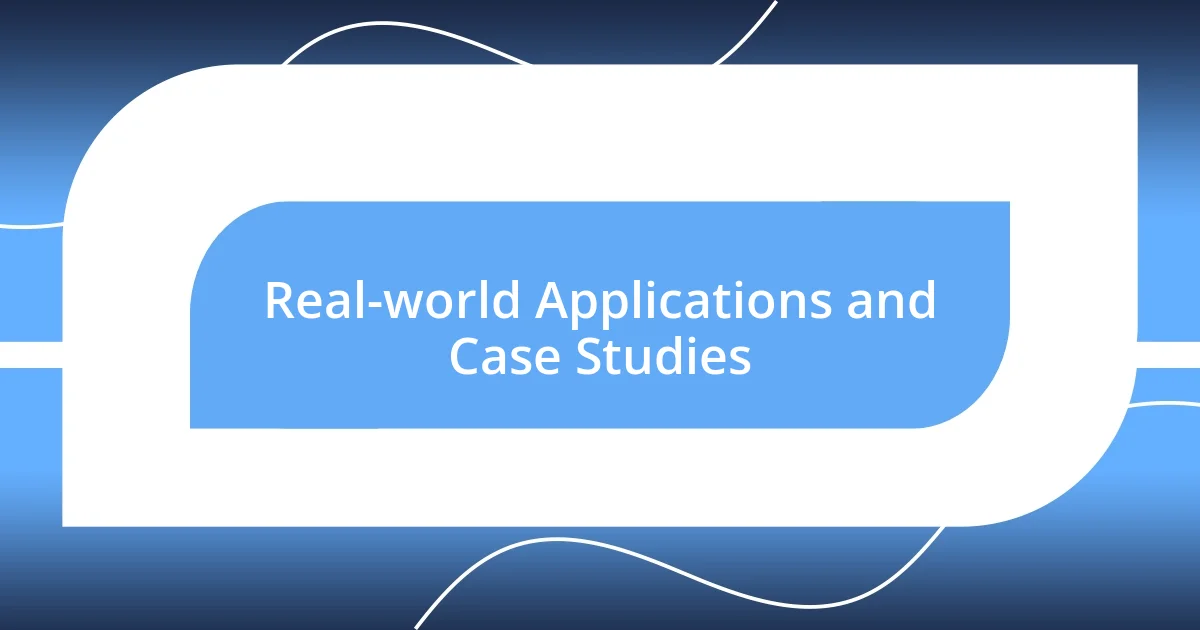
Real-world Applications and Case Studies
In the real world, I found that the applications of the Metasploit Framework extend far beyond just testing systems. There was a project I worked on where we used it to assess the security of a financial institution. Watching how quickly I could identify vulnerabilities and demonstrate the potential impact was eye-opening. Have you ever felt that rush when you realize the tool you’re using can reshape a conversation about security? It’s incredible to think how those findings not only assisted in patching critical gaps but also fostered a culture of awareness among the staff.
Another instance that stands out involved a simulated attack on a healthcare provider’s network. Utilizing Metasploit, we replicated tactics that real-world attackers might use. I vividly remember the moment we successfully demonstrated how an unpatched vulnerability could grant access to sensitive patient records. It felt surreal to bridge that gap between a simulated demonstration and the tangible risk to real lives. Don’t you crave that kind of clarity in your security practices? It reinforced to me that our work transcends the technical; we’re safeguarding trust and confidentiality.
I also recall a client case where we employed Metasploit for red and blue teaming exercises. The excitement in the room was palpable as we transitioned from being the attackers to strengthening defenses jointly. I felt a deep sense of fulfillment after the debriefing session, sharing insights that not only educated the client but also solidified ongoing collaboration. Has there been a moment in your work where you felt truly connected to a team’s mission? That kind of synergy made a lasting impact, emphasizing that the right tools can lead to profound, positive change in our cybersecurity landscape.












